A Deep Cycle Battery Assassin
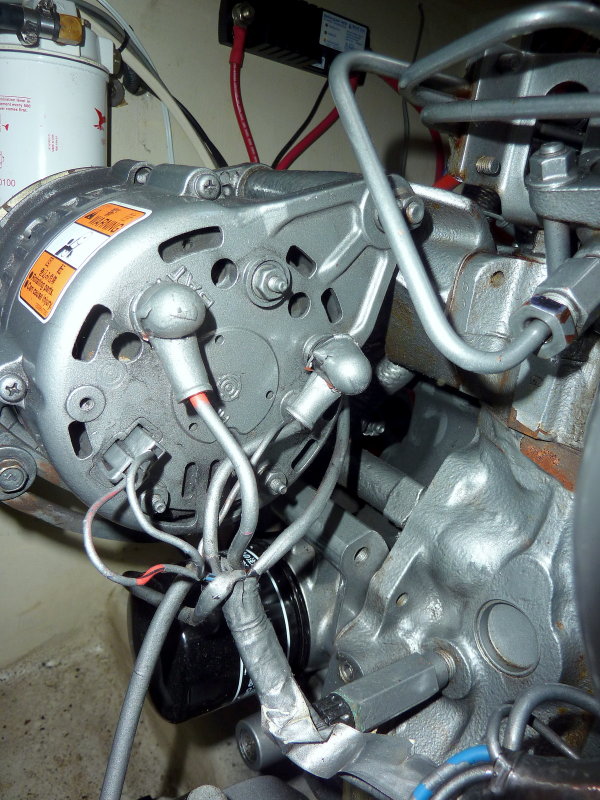
The alternator pictured here helped to destroy a very expensive bank of TPPL AGM batteries in under two years. These batteries need an absorption voltage of 14.7V. The highest voltage I recorded on this vessel was 13.58V at the battery terminals. At this rate it would have taken days not hours to fully charge these batteries. Both voltage drop and a “thermistor” auto type alternator were to blame.
Internal automotive type voltage regulators are one of the most often misunderstood devices out there. They are simple but they also vary quite a bit in how they regulate or limit voltage. All a voltage regulator does is limit voltage but some go a step further and try to protect the battery or protect the alternator itself.
Just because an alternator comes standard on a marine engine does not mean it is a marine duty or high performance alternator. In most every case these alternators are nothing more than a light duty automotive alternator slapped onto a marine engine.
Unfortunately, for boaters, automotive batteries are vastly different in the way they need to charge, when compared to a deeply-cycled marine battery bank. The auto battery sits in a hot engine bay, think summer time stop & go traffic, and the alternator is in there too. The auto industry and battery makers know that heat is a prime assassin of batteries. If the charge voltage is not compensated for when the batteries are hot they can become dangerously over charged.
In order to address these issues, in a rather Band-Aid like fashion, alternator manufacturers such as Hitachi, Mitsubishi, Denso, Delco, Paris Rhone/Valeo etc., etc. began adding a simple thermistor to the voltage regulation circuits as automobile load demands went up throughout the 70’s, 80’s and 90’s. The internal thermistor causes the regulators target voltage to decrease, as the alternator temp increases. The Hitachi/Yanmar voltage reduction is one of the most severe I’ve measured.
Unfortunately these reductions in the regulation limit voltage occur based on alternator or ambient alternator temperature regardless of whether the alternator is too hot from being over worked or not. Take for example a small engine bay on a typical sailboat, it is not uncommon to measure engine room temps of 145°F or more.
If we assume 145°F with a typical Yanmar / Hitachi alternator, based on the thermistor temp gradient built into the regulation circuit, we can see that at 68°F it should produce 14.4V +/- 0.3V (BTW +/- 0.3V is horribly SLOPPY). However, for every degree rise above 20°C/68°F, it reduces the regulation voltage limit by -.01V per degree Celsius. An engine bay temp of 145°F correlates to 63°C. An ambient temp of 63°C is a temp increase of 43° Celsius beyond the thermistors baseline of 20°C / 68°F.
43° X .01V = -.43V
With just an engine room temp of 145°F the highest regulation voltage we can attain is 13.97V. Keep in mind I have not even included for any heat generated by the alternator itself here, just the engine room temp.
This Band-Aid approach is marginally acceptable for an automotive battery, which is accepting a few amps of charge current in a 130°F engine space, but absolutely horrible for a deep cycled battery at 70°F accepting more current than the alternator can produce, while trying to get to a proper and healthy absorption voltage.
In an automotive application this feature serves to protect the battery, but in a marine application it serves to protect the alternator, (reducing charge voltage reduces accepted current the battery can take) but then serves to murder the batteries. Not all marine alternators use thermistor limited regulation circuits but more and more do as the years go on. Alternators such as the Motrolola style units on early Westerbeke and Universal engines, or the Leece-Neville 8MR series have simple “dumb regulators”.
Some of the crude definitions often applied to factory (automotive) alternators:
Dumb-Regulated – A simple dumb regulated alternator does BULK and ABSORPTION and that is it. There is no thermistor protection for over heating or battery temp compensation and they do “burn-up“, quite frequently, when used to charge large battery banks. If the voltage regulation point is 14.4V it will bring the bank to 14.4V and simply hold it there. If the regulator senses that it’s below 14.4V the alternator is in BULK mode putting out all the current it can based on rotor RPM and copper temperature. A healthy and long absorption charge is actually good for deeply cycled marine batteries and is the part of charging that serves to reconvert lead sulfate.
Super-Dumb-Regulated – Basically the same as above but they have an additional thermistor self-protection feature that reduces alternator regulation voltage based on alternators ambient temperature. These alternators are a poor match for deeply cycled batteries because they chronically under charge them, especially with the short duration engine run times sailors prefer when out cruising. When you reduce the voltage limit of the alternator you also greatly extend charging times. Voltage is the pressure that allows current to flow into the battery, low voltage = lower current and considerably slower charging.
Lowering the regulation voltage limit has the net outcome of reducing current output thus allowing the alternator to now cool off a bit and hopefully not cook itself. Thermistor type alternators are just basic inexpensive automotive alternators. Reducing voltage using a temp gradient is the least expensive way to get these alternators through the warranty period and not destroy hot automotive batteries in a few months. As applied to the marine market the alternator maker could care less about your batteries or how fast you destroy them, they only care about making it through the warranty period.
Certainly with 20+ hour motor runs, which are about as rare as fish with legs, getting back to 98-100% SOC is possible even with a “Super-Dumb” alternator regulator but this is many, many, many hours longer than it would take with a simple dumb-regulator or with an external smart-regulator set up correctly.
What about external regulation?
Smart Regulation – Smart-regulators handle the alternator a bit differently, in terms of protecting the alternator or reducing terminal voltage, to temp compensate the battery. Balmar and some other smart regulators, reduce the field voltage, which in turn reduces alternator current output. They can do this based on a high-limit for alternator temperature while still keeping the voltage limit set point exactly the same. The smart regulator does not begin reducing field voltage UNTIL the alternator hits the high-limit.
For example, the current output of a 100A alternator may be reduced to just 70A, to keep it below 230°F, but the pre-set voltage limit still remains at 14.4V – 14.8V, or where ever you set it at for your particular batteries. By temp protecting the alternator it does take slightly longer to get to the designed target voltage, but the target voltage has not changed or been reduced based on ambient engine room temps and the alternator is still climbing towards that voltage at the maximum safe temp it can do so. The only change in regulation voltage is that the time to get to the limit voltage is slightly extended so as not to cook the alternator.
Important:
Not all external voltage regulators are created equal in regards to alternator temperature protection. The Wakespeed WS500 regulators utilize an “predictive” alternator temp sensing algorithm that can “predict” where the alternator temp is going based on rate of temperature rise. This means the WS500 can run the alternator to within a 2-4 degree window of the alternators safe temp. In other words the WS500 can extract the maximum current that is safe for the alternator at all times. No other regulator can do this.
Other external regulators cut the field by 50% or 100%, wait for the alt to cool, and then go back to 100% output. This results in a ping-pong match between the regulator and alternator that looks like this.
100% > 0% > 100% > 0% > 100% > 0%
or
100% > 50% > 100% > 50% > 100% > 50%
Because the WS500 regulator is always seeking the maximum safe running temp of the alternator it yields the best continuous output performance. Expensive? Perhaps, but you really do get what you pay for.
Contrast how a WS500 regulator maximizes alternator output to a stock Yanmar / Hitachi alternator which reduces the regulation voltage limit/target based on ambient alternator temp, and there is no comparison in terms of charging performance. With smart-regulators the voltage limit is not reduced, just current output via the voltage applied to the brushes is reduced. Reducing current output slows charging a bit but nowhere as much as reducing the limit voltage based on ambient alternator or engine room temp. While reducing the current output does extend bulk charging time you still get a healthy absorption stage and you still get to the target voltage significantly faster. This type of regulation is more expensive and thus why cheap automotive type alternators don’t use it.
How is This So?
This image is a typical spec sheet for a Yanmar/Hitachi alt:
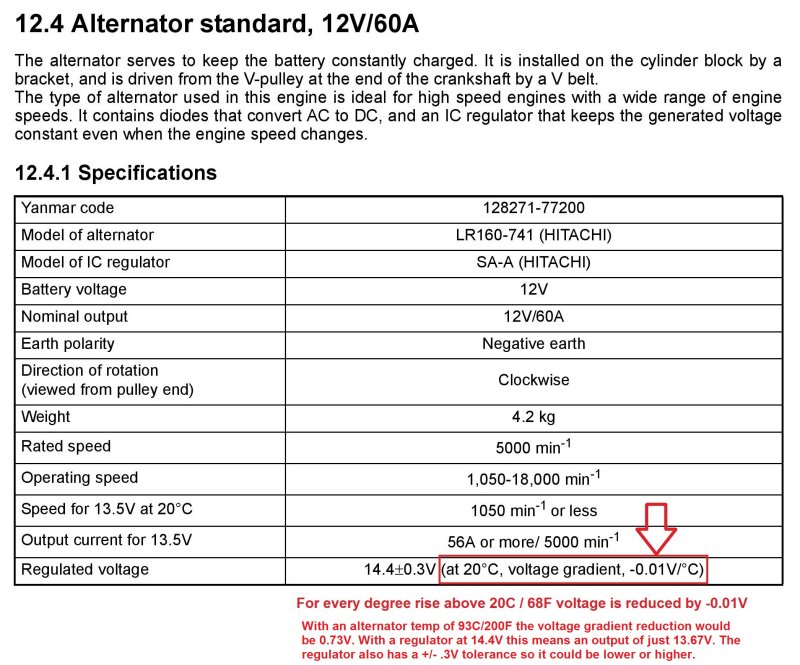
The regulation voltage is specified at +/- 0.3V which, in and of itself is pretty pathetic, but this is what you get from a $6.25 regulator. If the design voltage is for 14.4V then this means you could possibly get one at 14.1V or one at 14.7V. Kind of a luck of the draw of specification. D’oh..
Of course the regulation voltage limit only tells part of the story. You then need to subtract a voltage gradient caused by the thermistor, of -0.01V for every degree rise in Celsius above a 20°C baseline, which is 68°F (see red arrow & red box in image). If the alternators set point was 14.4v by the time the alternator gets to 200°F the limit voltage has been reduced to just 13.67V and this does not even consider any voltage drop in the system wiring between the back of the alternator and the battery bank. It is not at all uncommon to see an alternator charging large deep cycle banks at 225°F – 230°F so 200°F is actually being kind.
Want to make this debacle even worse? Imagine for a minute that somewhere along the way the PO or boatyard installed a diode isolator in the path of an automotive grade alternator. On top of the already low output voltage you now have an additional -0.6V to -1V drop in the alternators path. I have seen and measured 80A factory alternators barely able to deliver 10 or 12 amps to the batteries in what should be “bulk” charging. Low voltage at the battery terminals = low amperage output. Ouch!!
Proper Absorption Voltages:
The absorption stage and absorption voltage set point or limit are critically important to maintaining healthy batteries. Attaining the proper voltage and then keeping it at the desired set point, for the proper duration, means faster & healthier overall charging. Thermistor type alternators rarely if ever reach the proper absorption voltage, on deep-cycling banks. If they can’t even get to the proper absorption voltage, due to heat, then holding these voltages for the correct duration is simply a pipe dream. The correct absorption voltage and absorption duration are one of the most important aspects of deep cycle battery charging.
The reason the Yanmar/Hitachi alternators charge so slowly, and you rarely see anywhere close to rated output, except for a few minutes after a cold start, is because the regulator in them is actually not suitable for charging deep-cycling banks.
If you want to protect an alternator, to make it through the warranty period, reducing regulation voltage can work okay. If you actually want to charge batteries, used in deep cycling applications, and do so in a healthy manner, alternators with internal thermistor regulation are really quite pathetic.
In a marine application the regulator inside them is only about one thing, protecting the alternator from melt downs. It’s not about charging performance nor does it care about your batteries. Slap it in a car, where the batteries are always full, and you’re good to go. Put it in a boat with deeply cycled banks and they really perform horribly.
Cooked…!!
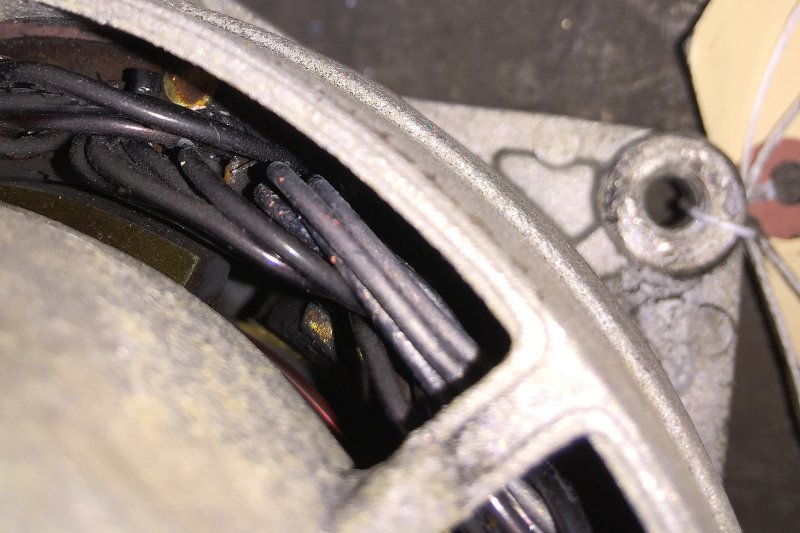
Just because an alternator regulator has a thermistor in it does not mean it will always protect your alternator from cooking itself. This alternator was charging a large bank of lead acid batteries, almost 900Ah. It got so hot that it had cooked the stator as well as melting the seal out of the front bearing. An external regulator with alternator temp protection could have saved this customer from an expensive repair where even the thermistor regulation circuit could not.
If you want to protect an alternator, to make it through the warranty period, reducing regulation voltage can often work okay, but it did not here. If you actually want to charge batteries, used in deep cycling applications, and do so in a healthy manner, alternators with internal thermistor regulation are really quite a poor choice.
New vs. Fried
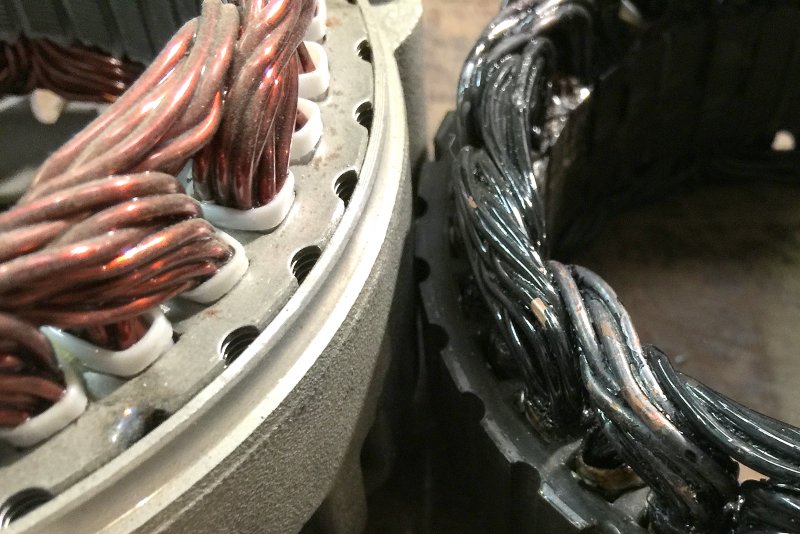
In case the context of the last photo was lost, this is a new stator and a fried stator. This alt was also thermistor protected but the battery bank was simply too large, and regularly over-discharged, for the alternator to adequately self protect itself. In this case a properly installed external regulator with an alternator temp sensor, would have saved this alternator.
Voltage Profile – Temp Protected Auto Alternator

So what does the charge voltage actually look like with a thermistor protected alt charging a deep cycle house bank? It looks like this.
This alternator was 80A rated feeding a 400Ah bank. In just 13 minutes the alternator was surpassing 225F (Fluke 289 with temp probe). At that point voltage stopped climbing and became somewhat steady. Once voltage was held steady the amperage output started to decrease slightly thus allowing some cooling of the alternator. About 18 minutes later the voltage rose to just under 13.7V but the alt temp had increased again so it continued to bounce along somewhere between 13.64V and 13.69V.
I data logged this voltage for 1.5 hours and it never exceeded 13.81V. Needless to say the batteries were getting chronically under charged and charging extremely slowly.
Voltage Matters
Voltage is the pressure that allows current to flow into the batteries and without a sufficient charge voltage only so much current will flow into the battery. This of course is based on its state of charge, internal resistance and actual terminal voltage. By reducing the terminal voltage you also reduce how much current the battery can accept.
The mooring sailed boat I created this graph from destroyed an expensive set of AGM batteries, using a Hitachi internally regulated alternator, in just 18 months. Ouch, expensive mistake. The owner blamed it on the AGM’s when in fact the AGM’s would have been fine had they been properly charged.
Voltage Profile – Smart Regulator
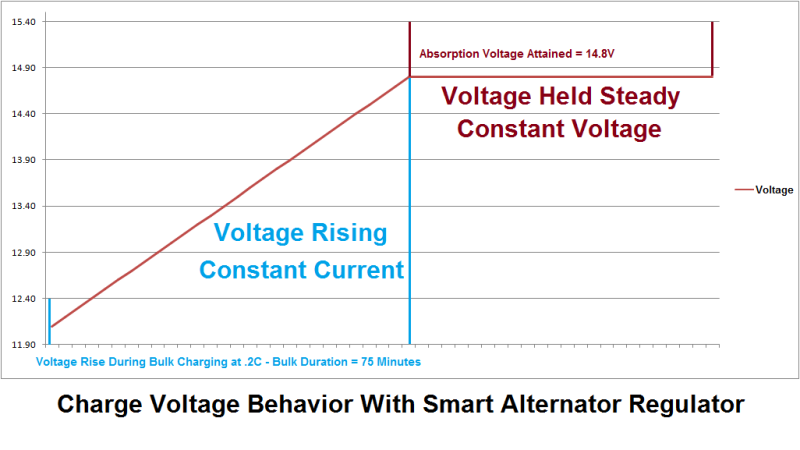
This boat has a large bank of Trojan flooded batteries and the alternator, with smart regulator, is sized at 20% of the banks Ah capacity (cold rating). With the smart regulator it took approx 75 minutes, at full output (though temp protected), of continually rising voltage during bulk, for the batteries to attain the absorption voltage limit of 14.8V. Once at 14.8V the voltage was held steady by the regulator while current began to decrease. By sizing your alternator to 20-25% of the banks capacity, using its hot rating, your can rather drastically reduce the bulk charge time.
This is what a healthy charge voltage profile looks like. The other bank, previously shown, never exceeded 13.81V in 1.5 hours yet this bank attained 14.8V at 75 minutes and then continued to hold the proper absorption voltage for these Trojan Batteries. These batteries were in their 8th year ad still going…
Do I Really Need a High Performance Alternator?
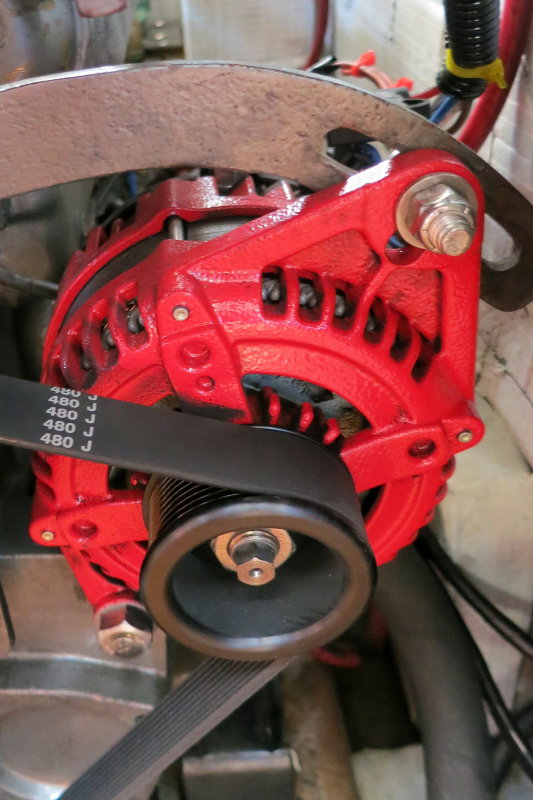
Large Banks:
Pictured above is a Balmar AT Series “small case” alternator 9Has been replaced by the XT series. This one uses Denso licensed hairpin stator / rotor design. For a small case alternator it was a very good performing alternator. Balmar has since re-designed its highest performing small frame alternator with the new Balmar XT-170.
Because most sailboat auxiliary engines use small-frame alternators, owners are often limited in amperage from 80A to around 175A. Anything over 100A will require a serpentine or a dual-v belt system. Still, an externally regulated 80A alternator will run circles around an 80A internally regulated alternator in terms of healthy charging performance.
When ever possible, when charging large Ah banks, it is best to try and fit a large frame alternator designed specifically for a heavy duty applications. Small case alternators, even “high performance” models, despite what many folks think, are not constant duty rated, not even the Balmar XT series is “constant duty”. If your bulk charging will be longer than about 30 minutes even a Balmar XT will need to be current limited, via the external regulator, to make it last.
Medium Banks:
Other options for higher performance small case alternators would include the Balmar 6-Series alternators. The 6-Series alternators are a bit less expensive than the Balmar XT series and are suitable for many medium sized banks, and even larger banks, with a properly current limited external regulator such as a Balmar ARS-5 or MC-614..
Small Banks:
For a bank in the 150Ah to 400Ah range you may not need the performance of a Balmar XT or a 6-Series alternator. To fill this niche Compass Marine Inc. has developed the cost effective, Yanmar fit, AMP-IT-80-ER. (AMP-IT IS OUT OF BUSINESS DUE TO HEALTH ISSUES) What you need for an alternator will depend entirely on your actual use and battery bank chemistry. Despite everything I have just written above, the answer may actually be;
No, you may not need a high-output alternator.
What you need will depend largely on use, bank size and desired daily Ah consumption as well as battery chemistry type. You will also need to consider your maximum desired engine run time. If you only day sail, and tie to the dock every night with shore power charging, converting the factory alternator, to a higher performance model, will gain you little. This is why; it’s all about use.
What should I do if I have a….?
Dumb Regulator With Low Voltage Set Point:
If you have an old 13.6V – 13.8V regulator, and wet cells, ditch it and get a regulator that is a minimum of 14.2V – 14.4V or even 14.6V and you will charge a lot faster. Battery gassing generally begins above 14.3 volts, though is temp dependent, so a dumb reg that does 14.5V – 14.6V will cause your batteries to need water added more often. 14.4V would be better maintenance wise but 14.6V will charge even faster and is arguably going to fend of sulfation better. If you are a coastal cruiser doing 40 engine hours per year this is a perfectly adequate option. Best case here is to convert the stock alternator it to external regulation or consider one of the entry level externally regulated AMP-IT alternators manufactured by Compass Marine Inc..
Dumb Regulator :
(Non-thermistor model) This can do marginally well provided you have flooded batteries, minimal voltage drop in the system and it regulates to around 14.4V or so. It should match closely to the specified absorption set point of your batteries. While a single absorption voltage is arguably less than ideal, if you are not a full time cruiser, and tie to the dock regularly, an arrangement like this can suffice. Be aware that with a medium to large bank you can very easily burn up a “dumb-regulated” alternator, if you discharge too deeply.
Super-Dumb Regulator:
(thermistor compensated) If you tie to a dock after each sail and put the vessel on a shore charger, you can probably keep this alternator. If you actually cruise regularly, & deeply cycle the batteries, do yourself a favor and convert it to external regulation or upgrade to a higher performance alternator & regulator.
Voltage Sensing Improvements:
Stacked on top of the voltage gradient issues, stock alternators also suffer horribly from voltage-drop between the alternator and the battery bank. Some stock alternators can be set up or wired to provide better external voltage sensing, at the battery terminals, as opposed to the back of the alternator itself. Please do not try this if you don’t know what you are doing. Any good alternator shop can help you with this and it can make a difference in charging performance. The only way to get accurate voltage sensing is for the negative regulator lead and the positive sense lead to be direct wired to the battery bank. This is not always possible with factory alternators and you only typically get a positive volt sense lead to work with. For more information on the role accurate alternator sensing makes to performance please read:
How do I Measure the Voltage Set Point/Limit of My Existing Regulator?
- Make sure the batteries are at 100% state of charge
- Make sure the alternator & engine room are cold/ambient temp
- Turn off all DC loads & charge sources including solar
- Start the engine and using a DVM test the voltage at the alternators B+/Output terminal & B- or case of the alternator
- Wait for voltage to stabilize
- Voltage should be somewhere around *14.2V & *14.4V
IMPORTANT:
*Many regulators on Universal engines were factory set at 15.0V to try and compensate for the horrible factory wiring. Many Delco regualtors are also as high as 14.8V – 15.0V. I do not recommend using single SET-point voltages, with this high of a voltage, especially when charging into full batteries such after leaving a dock after being on shore charging.
When do I Need a High Performance Alternator & Regulator?
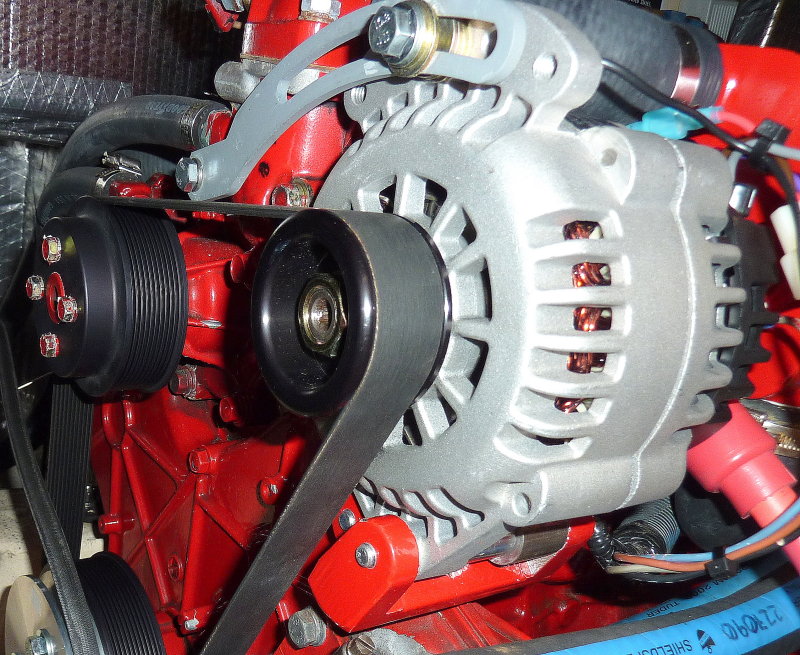
Did I over Think My System?
In my opinion, a lot of coastal & weekend only boaters, with inexpensive automotive type G-24, 27 & 31 flooded batteries, who are tied to shore charging all week, can & do sometimes over think and over blow charging systems. There is nothing wrong with this, it is not at all going to harm anything, so long as your wallet can handle the punch.
What Battery Chemistry Do You Have?
With certain battery types though you really do need to design and install a proper alternator based charging system. The reality for us here at Compass Marine Inc. is that we see less than 35% of the boats out there using AGM, GEL or AGM TPPL batteries, yet nearly 50% of the coastal/weekend cruisers have a fully gourmet 1.5K+ alternator charging systems. Many who are dockside most of the time and as a result have no dire need for a system this fancy. Money wasted? Some times yes, when based on actual use. Like anything, be realistic about your usage. Bottom line? If you’ve spend good money on AGM, TPPL AGM, GEL or LiFePO4 batteries then yes, you do need a proper alternator charging system!
When Should I Use External Regulation?
Flooded Cell Batteries:
If the bank exceeds the hot rated alternator capacity by more than 80% I recommend a smart regulator & temp sensing of both the battery bank and alternator. Eg; a 400 Ah flooded bank is comfortable with about 100 amps in bulk so a 70 amp alternator, using its hot rating, would get external regulation with alternator temp sensing at the least.
TIP:
We generally recommend installing an alternator that is one or two size larger, than is desired in output, & then derate the max current output in the regulator. This allows the alternator to work less hard , run cooler & live a longer life. This can be done with Balmar regulators by using the Belt Load Manager feature.
AGM Batteries:
I always recommend external regulation with alternator and battery temp sensing at a minimum. I have seen a number of dumb & super-dumb regulated alternators burned up by the high acceptance rates of AGM batteries. On battery temp compensation is a minimum requirement for all AGM batteries, and factory alternators don’t do this correctly.
GEL Batteries:
I always use external regulation with alternator and battery temp sensing at a minimum. GEL’s require specific voltage ranges that dumb regulators just can’t accommodate very often. On battery temp compensation is a must have with GEL batteries.
TPPL AGM Batteries:
Same as AGM except that some TPPL AGM batteries want to see a minimum charge current (MINIMUM not maximum) of 40% of rated Ah capacity or a 160A alternator for a 400Ah bank (hot rated output not cold). Charging at less than 40% of Ah capacity can negatively impact the cycle life of TPPL AGM batteries. At a bare minimum you want to be hitting these batteries with 30% of Ah capacity or more in bulk charging current.
Dumb Regulator / Temp Compensated (Hitachi/Yanmar etc.):
These factory alternator regulators are horrible for deep-cycling applications. Almost every Yanmar engine with a Hitachi alternator, if used regularly in a deep cycling application, should be converted to external regulation or convert to a new alternator & regulator.
Dumb Regulator / Low Voltage Set Point:
If your alternator regulator is set to less than 14.2V it would be wise to invest in a better regulator.
Inaccurate Voltage Sensing:
This piece of the charging puzzle can not be over looked. Many factory systems have horrendous voltage drop between the battery bank and alternator. These alternators are what is commonly referred to as self-sensed meaning they measure system voltage at the alternator BEFORE ANY VOLTAGE DROP has even occurred. This will cause the alternator to go into the absorption/CV (constant voltage)/ voltage limiting stage prematurely. External regulators correct for this by allowing positive and negative regulator wires (volt sensing) to be routed directly to the battery terminals. This can yield significant increases in charging performance. For more info on this see: Alternators & Voltage Sensing (LINK)
The AMP-IT Yanmar Fit Externally Regulated Alternator
EDIT: 12-1-2021
AMP-IT has been closed due to health issues. Balmar is your best bet.
For those who have a Yanmar with a Hitachi factory alternator, and don’t want to spend $1000.00 plus on an alternator upgrade, Compass Marine Inc. recently developed the 80A entry level Yanmar/Hitachi frame alternator that is already set up for external regulation. The AMP-IT-80-ER can be paired with a Balmar ARS-5 or Balmar MC-614 and represents an excellent performance upgrade value. We also offer the AMP-IT-100-ER and the AMP-IT-HD125-ER
For boat owners with Motorola/Prestolite/Leece-Neville 8MR case alternators MarineHowTo.com has an article HERE that shows how to convert your own Leece-Neville alternator to external regulation. CMI also now has a 105A version of this alternator, already converted to external regulation & ready to go: AMP-IT-105-ER.
External Regulators: For external regulators we recommend Balmar or Wakespeed.
Summary:
In short, smart regulators and performance alternators most definitely do have a place on cruising boats and they’re tremendous tools. However, their use should ideally be well justified for the expense laid out.
The installation of a smart regulator should be considered in the total system design. Their use is almost always a justifiable expense for a cruiser, but occasionally it is not, for a typical day sailor, who ties to shore charging each night.
A small bank of inexpensive flooded batteries, for a day boater or weekend cruiser, does not always require a $1000.00 + charging system like a cruising sailboat or trawler would need. A good battery monitor, properly programmed, or another way to monitor SoC performance, such as the Balmar Smartgauge or the new Balmar SG-200 should ideally be your first place to start discovering your actual usage. The Victron BMV-700 is also an excellent value-point battery monitor.
If you want, need or desire expensive high-acceptance batteries, or a very large Ah bank, the suggestion would be to invest in an external regulator and a higher output externally regulated alternator. If your batteries are located in a hot engine compartment then you really should have an external regulator with battery temp compensation. Heat kills batteries and the voltage needs to be compensated when batteries are hot.
As always please design your charging system, as just that, a system.
Good luck & happy boating!
Let’s Keep This Site Running!
Like what you saw or read? Would you like to see more articles like this? Is so feel free to donate, support the site and keep it growing. I am trying my hardest to keep this information FREE. If you liked it, learned from it or I saved you some money feel free to make a small donation, that’s all I ask.

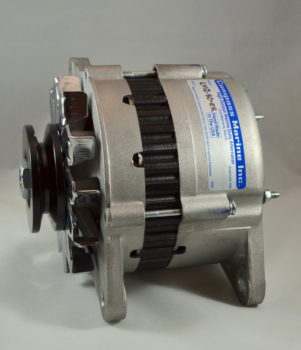
This is such an informative article, written in such a way that it’s really easy to understand. Thanks very much.
My new ( 2015 ) Myanmar was ordered with serpentine belt and 120 amp alternator. It is a Valeo not Hitachi. Does it also have the thermistor?
It consistently under charges as you describe for the Hitachis